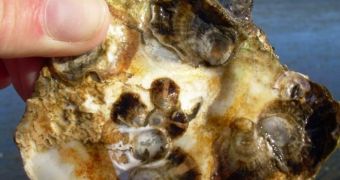Investigators at the Oregon State University (OSU) say that oyster seed production has collapsed in recent times, due to the encroaching influence of oceanic acidification. The phenomenon is very severe, since it can have global repercussions.
Ocean acidification is a process through which the pH levels of water around the world is slowly decreasing. The phenomenon is caused by the massive amounts of carbon dioxide we release into the atmosphere each year.
Oceans are natural sponges for CO2. Phytoplankton at the surface consume the chemical, and then carry it to the bottom of the sea as they die. But an excess of carbon in the air can lead to the creation of carbonic acid in the oceans, which lowers the pH levels of water.
Acidification has a number of adverse effects, such as promoting species loss, ecosystem degradation, and so on. Coral reefs – the most important hot spots for biodiversity in the sea – are severely damaged by increasingly acidic waters, as are all creatures that have shells.
An acid environment removes calcium carbonate from shells, making them brittle and frailer, and promoting changes in the delicate interplay that is the marine food web. All of these effects, and more, are currently leading to an accelerated rate of species loss.
At the Whiskey Creek Shellfish Hatchery, in Netarts Bay, owners found that oyster seed production was significantly impaired. They called on experts to help them figure out what was going on.
Scientists determined that the water was contaminated with high amounts of CO2, and that the corrosive environment was preventing the larval oysters from developing their shells. The acidic waters also slowed down the pace at which the oysters normally developed.
The new study is published in this week's issue of the journal Limnology and Oceanography, which is edited by the Association for the Sciences of Limnology and Oceanography (ASLO). The US National Science Foundation (NSF) provided the funds necessary for this investigation.
“Studies funded by NSF's SEES Ocean Acidification solicitation are well-positioned to determine the specific mechanisms responsible for larval mortality in Pacific Northwest oyster hatcheries,” NSF Division of Ocean Sciences Program Director David Garrison explains.
“This is one of the first times that we have been able to show how ocean acidification affects oyster larval development at a critical life stage,” OSU chemical oceanographer Burke Hales concludes.

 14 DAY TRIAL //
14 DAY TRIAL //